The readers are sometimes called to prepare a home to receive some kind of alarm system, which may include placement of sensors and wiring. They must also install the power supply for the system, which includes outlets, wires for sirens, and other alarm transducers.
So, it is important they know how the basic system works to help in the installation or troubleshooting. The following are some of the basic alarm and security systems.
Magnetic sensors and switches
The simplest alarm system uses a switch to trigger a siren or another sound or light source. Figure 1 shows a diagram of a system that uses a magnetic switch placed in a window.
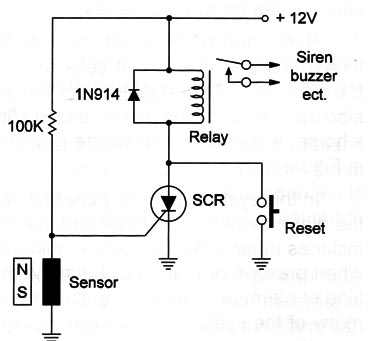
With the window closed, the magnet is in contact with the reed switch, keeping the contacts closed and the circuit off. If the magnet is moved away from the reed switch, the contacts open and the alarm is triggered. Many switches of this kind can be wired in series to protect all the windows and doors of a house or building.
The relay is open until one of the sensors is activated. Once triggered, even if the window or door is closed again, the circuit remains on. To stop the alarm it is necessary to turn off the power supply, pressing S1 for a moment. Any number of sensors can be wired in series.
Notice that in this circuit, the current flowing across the sensor is very weak, allowing the use of cells or batteries for power. Many dealers offer the sensors for this type of alarm, and also the detectors, the sirens, and in some cases, complete kits to protect a home.
A complete alarm system includes additional resources as shown in Figure 2.
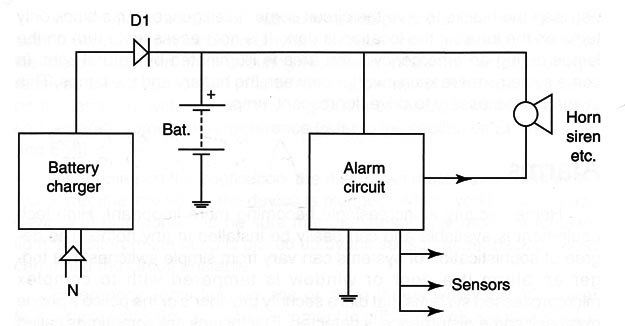
In this system, a battery charger keeps the battery charged to power the alarm even if an intruder cuts the AC energy supply. The circuit also includes other sensors, such as microswitches (small switches activated when pressed or if an object is moved).
When installing or repairing this kind of alarm an electrician doesn't need to be extremely experienced as many of the systems are simple, but must take care with the isolation of the wires to the sensors.
Another system includes in the sensor a radio transmitter that sends a signal to a receiver. If the sensor is activated, the signal changes and the alarm is triggered. This system is suitable for cases where there is no space to pass common wiring.
Photoelectric
The use of photo sensors in alarms is common in many applications.
Figure 3 shows a passage alarm or passage detector using a phototransistor as the sensor and an IR (infrared) LED as the radiation source.
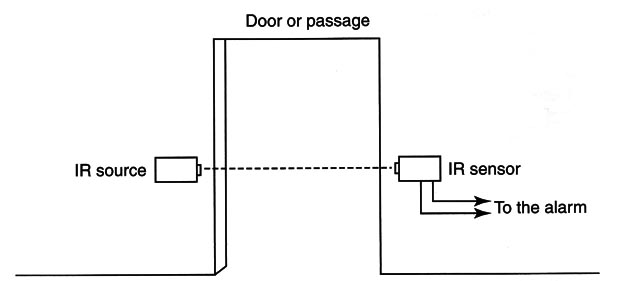
This circuit detects when a person or object cuts the radiation beam, even for a fraction of a second, in the sensor. The use of IR is recommended as the intruder can't see it, and therefore can't see where the system is placed.
Many circuits operate with modulated IR, meaning the circuit doesn’t produce a continuous light beam, but produces short pulses in a certain frequency to be detected by the sensor. This procedure is used to avoid an intruder using a “false” IR source to stall the alarm as suggested in Figure 4.
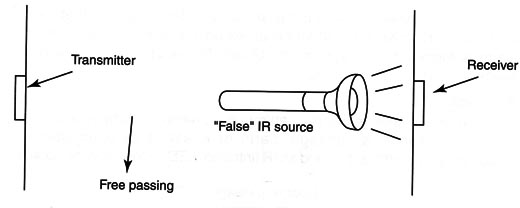
When installing or working with this kind of device, an electrician must be careful with light sources that can cause interference in the system, such as fluorescent lamps. If large areas must be protected, the alarm can use a laser as its IR source (figura 5).
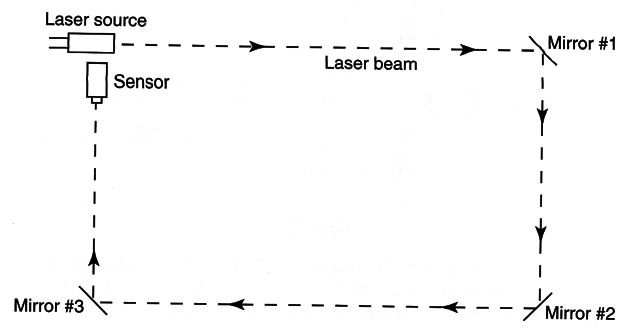
Mirrors can bend the IR laser beam, fencing a closed area against any intruder. If the laser beam is disrupted on any side of the area, the alarm will be triggered.
Motion Detectors
Motion detector alarms use a piroelectric sensor. It is formed by piezoelectric material that presents a surface electric charge that change according to the amount of IR radiation falling onto it. Because a certain degree of IR radiation always exists, the circuits are designed to detect small changes in this radiation from the presence of a warm-blooded creature, such as a human.
To detect the very small changes in the radiation, the circuit used is extremely sensitive and can be complex, involving special ICs.
Vibration Alarms
Small vibration sensors are placed in home or shop windows to detect any type of impact or vibration. The circuit for this type of sensor is the same as in the magnetic switch.
Ultrasound
In the ultrasound or super-sound system, the air is filled with inaudible sound vibrations (above 20,000 Hz). A sensor is placed to monitor these vibrations. The system makes an “image” from the pattern of direct and reflected sound waves and any alteration due to movement of an object-an intruder-when detected by the circuit.
The sensors and the emitter must be placed in the positions indicated by the manufacturer as it is sensitive to external interference.




